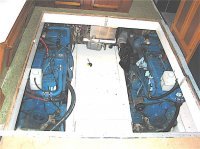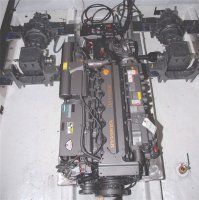fcdrifter13
Newbie
Hey all first post, been doing some learning.
Have a chance to buy a 43ft GulfStar MKII that has sadly had both of its perkins 120hp engines destroyed both to water ingestion. The boat is in otherwise great condition. I also have access to a Cat 4.4 t4f engine that has been dpf, scr, and def deleted. This engine at 100% load uses 8.1gph and produces 250hp@2200rpm and 600ft/lbs@1400rpm.
Had the idea pop into my head to throw two Linde 55 hydrostat motors on the back through a twindisk mount and run the props hydraulically. While the total overall HP would decrease the torque is increased by 200ftlbs. There would be a considerable weight savings as well as space savings so I could put in larger fuel tanks if wanted. Was only looking to cruise at 5.5-7knts not looking to get anywhere in a hurry. From my understanding the boat currently has 22 x 17 props.
Would someone be able to break down the math on what i would be looking at power consumption wise with those props. I found a few calculators that all give me different answers. One says that the power required would only be 21hp to go 7knts and that does not seem right as I could deliver that power at just off idle to both props and even may be able to increase speed through the hydrostat with the available torque.
Have a chance to buy a 43ft GulfStar MKII that has sadly had both of its perkins 120hp engines destroyed both to water ingestion. The boat is in otherwise great condition. I also have access to a Cat 4.4 t4f engine that has been dpf, scr, and def deleted. This engine at 100% load uses 8.1gph and produces 250hp@2200rpm and 600ft/lbs@1400rpm.
Had the idea pop into my head to throw two Linde 55 hydrostat motors on the back through a twindisk mount and run the props hydraulically. While the total overall HP would decrease the torque is increased by 200ftlbs. There would be a considerable weight savings as well as space savings so I could put in larger fuel tanks if wanted. Was only looking to cruise at 5.5-7knts not looking to get anywhere in a hurry. From my understanding the boat currently has 22 x 17 props.
Would someone be able to break down the math on what i would be looking at power consumption wise with those props. I found a few calculators that all give me different answers. One says that the power required would only be 21hp to go 7knts and that does not seem right as I could deliver that power at just off idle to both props and even may be able to increase speed through the hydrostat with the available torque.


